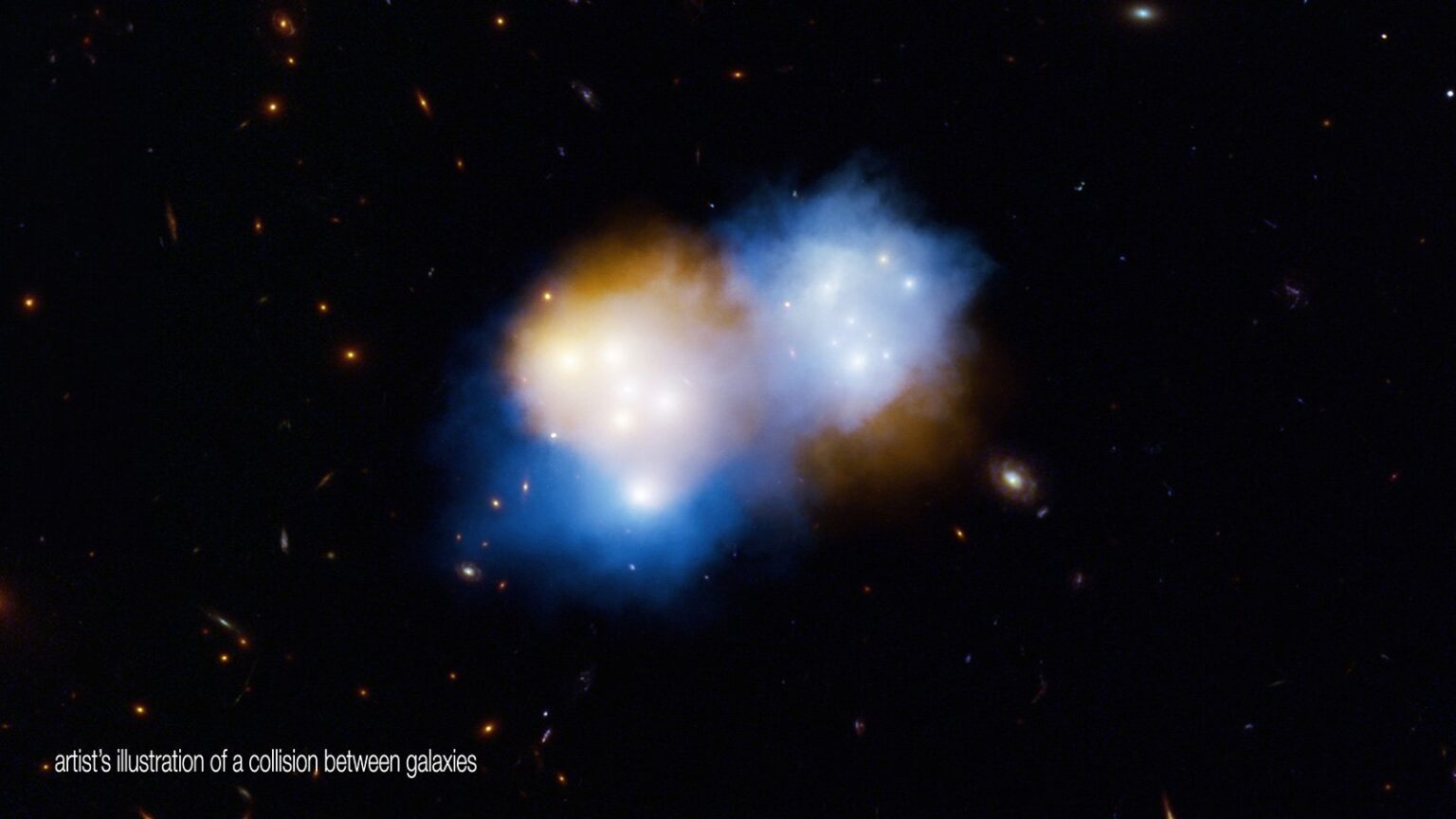Scientists were able to see the collision of two clusters of galaxies. Each of them is surrounded by dark matter, forming a peculiar halo. And now researchers know that in such extreme events, it actively interacts with the normal one and flies off in all directions first.

Two mega galaxy colliding
Astronomers have unraveled a messy collision between two massive galaxy clusters in which huge clouds of dark matter have separated from so-called normal matter. Both clusters contain thousands of galaxies and are located billions of light-years away from Earth.
When they penetrated each other, dark matter — an invisible substance that experiences the force of gravity but does not emit light outpaced normal matter. The new observations are the first to directly investigate the velocity separation between dark and normal matter.
Clusters of galaxies are some of the largest structures in the Universe, glued together by the force of gravity. Only 15% of the mass in such clusters is the normal matter that makes up planets, people, and everything you see around you. Predominantly it is represented by hot gas, and only a small part of it is stars and planets. The remaining 85% of the mass of the cluster is dark matter.
During the collision, which occurred between the cluster known as MACS J0018.5+1626, the individual galaxies were barely affected because there was so much space between them. But when the vast stores of gas between galaxies (normal matter) collided, the gas became turbulent and superheated.
Interaction of normal and dark matter
Although all matter, including both normal and dark matter, interacts through gravity, normal matter also interacts through electromagnetism, which slows it down during collisions. So, while normal matter stuck around, the clusters of dark matter in each cluster sailed on through.
Imagine a mass collision of several dump trucks hauling sand, suggests Emily Silich, lead author of a new study describing the findings in The Astrophysical Journal. “The dark matter is like the sand and flies ahead,” she says. Silich is a graduate student who works with Jack Sayers, a physics professor at the California Institute of Technology and the study’s principal investigator.
The discovery was made using data from the California Institute of Technology’s Submillimeter Observatory, the W.M. Keck Observatory on Maunakea, NASA’s Chandra X-ray Observatory, NASA’s Hubble Space Telescope, the European Space Agency’s Herschel Space Observatory and the Plunk Observatory, and the Atacama Submillimeter Telescope Experiment in Chile. Some observations were made decades ago, while full analysis using all datasets has occurred within the last few years.
Separation of normal and dark matter
This separation of dark and normal matter has been observed before, most famously in the globular cluster. In this collision, you could see hot gas clearly lagging behind dark matter after two clusters of galaxies shot past each other. The situation that occurred in MACS J0018.5+1626 (hereafter MACS J0018.5) is similar, but the orientation of the merger is rotated about 90 degrees relative to the Bullet Cluster.
In other words, one of the massive clusters in MACS J0018.5 is flying almost directly toward Earth, while the other is racing away from it. This orientation gave the researchers a unique vantage point from which they first determined the velocities of dark and normal matter and figured out how they separate from each other during collisions of galaxy clusters.
Sunyaev-Zel’dovich kinetic effect
The researchers used an observational technique known as the kinetic Sunyaev-Zel’dovich (SZ) effect to measure the velocity of normal matter, or gas, in the cluster. Sayers and colleagues first detected the kinetic Sunyaev-Zel’dovich effect on a single cosmic object, the galaxy cluster MACS J0717, back in 2013 using CSO data (the first observations of the kinetic Sunyaev-Zel’dovich effect made for MACS J0018.5 date back to 2006).
The kinetic SZ effect occurs when photons from the early Universe, the cosmic microwave background (CMB), scatter on electrons in hot gas on their way to us on Earth. Photons experience a shift, called Doppler shift, due to the movement of electrons in gas clouds along our line of sight. By measuring the change in CMB brightness due to this shift, researchers can determine the velocity of gas clouds in galaxy clusters.
By 2019, researchers had made these kinetic SZ measurements in several galaxy clusters, which allowed them to determine the velocity of gas, or normal matter. They also used the Keck telescope to find out the speed of galaxies in the cluster, which gave them an approximate speed of dark matter (since dark matter and galaxies behave similarly when they collide).
But at this stage of the study, the team had a limited understanding of the orientation of the clusters. All they knew was that one of them, MACS J0018.5, showed signs of something strange – hot gas, or normal matter, was moving in the opposite direction from dark matter.
The team also worked with Adi Zitrin of Ben-Gurion University of the Negev in Israel to use Hubble data to map dark matter using a technique known as gravitational lensing.
Why do normal and dark matter move in different directions?
In addition, John ZuHone of the Center for Astrophysics at Harvard and Smithsonian Institutes helped the team model cluster collisions. These simulations were used in combination with data from various telescopes to finalize the geometry and evolutionary stage of the cluster collision. The scientists found that before the collision, the clusters were moving toward each other at about 3,000 kilometers per second, or about 1% of the speed of light.
With a more complete picture of what was happening, the researchers were able to figure out why dark matter and normal matter turned out to be moving in opposite directions. Although scientists say it’s hard to imagine, the orientation of the collision, combined with the fact that dark matter and normal matter have separated from each other, explains the strange results of the velocity measurements.
In the future, researchers hope that more studies like this one will lead to new clues about the mysterious nature of dark matter. “This study is a starting point to more detailed studies into the nature of dark matter,” Silic says. “We have a new type of direct probe that shows how dark matter behaves differently from normal matter.”
Sayers, who recalls first collecting data on the site nearly 20 years ago, says: “It took us a long time to put all the puzzle pieces together, but now we finally know what’s going on. We hope this leads to a whole new way to study dark matter in clusters.”
According to phys.org


